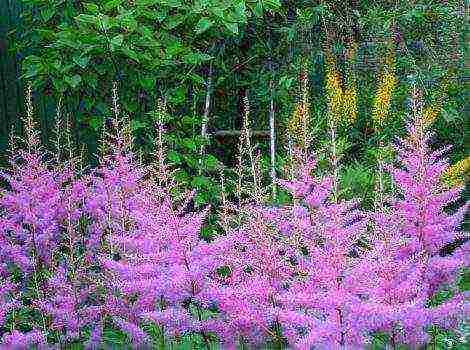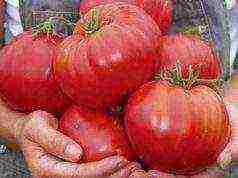Content
- 1 Varieties
- 2 Maren Oleron
- 3 Gravette
- 4 Belon
- 5 Oyster types: fin de clair
- 6 Specialist
- 7 Croesus
- 8 Blue shell
- 9 Brittany
- 10 Oysters white pearls
- 11 Khasanskaya
- 12 Aniva oyster
- 13 Posiet oyster
- 14 Japanese
- 15 Types of oysters
- 16 How to open?
- 17 How to eat correctly?
- 18 Cooking secrets
- 19 Beneficial features
- 20 The harm of oysters and contraindications
- 21 Compound
- 22 Oysters and mussels: differences
Black and white truffles
Truffle is a mushroom of the genus of marsupials, of the order ...
Turnip recipes and their photos
For the most part, turnip recipes were ...
Types of edible mushrooms: names, photos and descriptions
The best mushroom season is autumn. But there is ...
"Berries and vegetables" in the garden
Berries in the garden in the middle lane of our ...
Parsnip recipes
Parsnip recipes are little known and rarely ...
Percentage of starch in foods
Starch (polysaccharide) is necessary for a person, ...
Recipes for cooking dishes from stalked celery: photos and instructions
Recipes with stalked celery in the last ...
Proper nutrition for constipation: what you can and cannot eat
As with other diseases of the gastrointestinal tract, the main ...
Stalked celery dishes
Now there are several new varieties ...
The value of meat in human nutrition
Meat in human nutrition is present in the ancients ...
Information about the extraction of oysters takes us back to time immemorial - in the Neolithic settlements of a person who settled along the coasts of the oceans, the shells of these mollusks are found in huge quantities. In Korea, South Primorye, as well as in Japan, the length of ancient oyster heaps sometimes reaches hundreds of meters. In this article, we will look at the most common types of oysters, which are listed below.
Varieties
Almost 50 species of these molluscs are known in nature, the majority of which can be eaten. They most often choose tropical seas for living, but there are several species that live in the waters of the cold northern seas.
Oysters can be divided into 2 groups depending on the shape of their shell: flat, deep and round. The flat ones, which are most appreciated by lovers of this seafood, live on the numerous shoals of the Mediterranean and Atlantic shores. This species is represented by 4 varieties, each of which has its own unique taste, its own price category, as well as external features.
Maren Oleron
These types of oysters in France have the same name as their habitat - the Marene Oleron region, the province of Charente. They are the most outstanding representatives of this group of shellfish and have long been recognized by gourmets from all over the world for their amazingly delicate taste. The main characteristics are considered to be the presence of shells of an almost round shape, as well as the greenish color of the meat.
Gravette
These oysters grow in the Arcachon basin. They are quite fleshy, despite their small size, and also taste unsalted. Their carapace is greenish-yellow.
Belon
We continue to consider the types of oysters. The list will be incomplete, if not to say about the belon. They also got their name from their habitat - a small coastal village located in the north of the province of Brittany. Today, almost all oysters that are grown in Brittany have received this name. Their distinctive feature is a grayish-white color, as well as the presence of a sharp iodine odor.
Oyster types: fin de clair
They are named after the cages where they are grown. The duration of this process is one month, while up to twenty individuals can be located on one meter at once. Special varieties of algae are used as supplementary food.
Specialist
These types of oysters differ from the previous variety in fleshiness and greater density.Such qualities are obtained due to two months of keeping mollusks in special cages. 10 individuals live on one meter of the area.
Croesus
These types of oysters are bred off the coast of Ireland and Normandy. The cold Atlantic waters have an interesting influence on the development of these molluscs, contributing to the increase in the density and fat content of the meat.
Blue shell
These oysters are bred and raised in an interesting way. In the 2nd and 3rd year of life, they are transplanted into special pools filled with blue clay. This is done to enrich them with additional amounts of trace elements (phosphorus, iron, copper, zinc) and vitamins.
Brittany
These types of oysters are grown on the southern coast of the province of the same name in France. Their unique characteristic is a rich, pungent taste with a slight metallic aftertaste.
Oysters white pearl
Considering the types of oysters for pearls, this one is worth highlighting. They have a graceful shell shape in which this mineral grows. Seafood connoisseurs also recognize them immediately by their pungent iodine odor and pleasant sweet taste.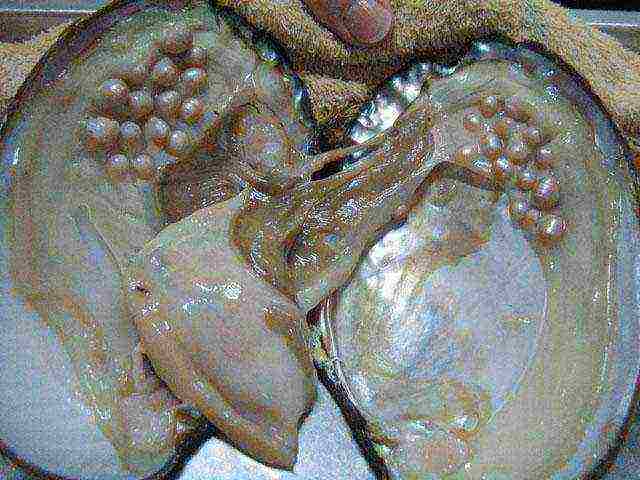
Khasanskaya
These oysters are characterized by a longitudinally wavy structure. The colors of the shells are from snow-white to dark olive or burgundy. This mollusk is the most laborious to catch - it is caught on underwater rocks, great depths, in places with fast currents. Has a unique ratio of total weight to body weight. We can say that this is the most beautiful oyster in existence.
Aniva oyster
This oyster can be called a fine nature with a strong character. It lives on Sakhalin Island, near the village of Solovyovka, in the Aniva Bay, which is why it got its name. This shellfish is so popular that neighboring Japanese periodically visit Sakhalin specifically for it. The deep, elongated, narrow shape of the shell, reminiscent of a boat, an interesting salty flavor and a soft greenish color make it stand out from the rest of the oysters.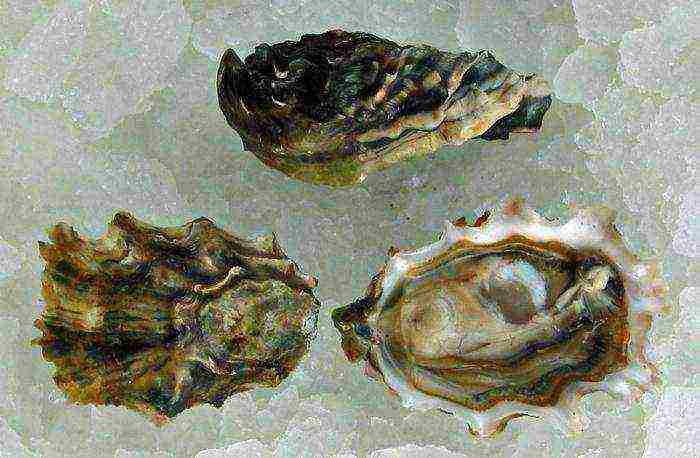
Posiet oyster
Considering the different types of oysters, it is worth highlighting this one. She is very exotic, because she lives on bioherms (underwater hills), the lower part of which is buried 10 meters into the depth of silt. Interestingly, in the study, the valves of the lower layers of extinct oysters were about 8000 years old. This period coincides with global warming, as well as rising sea levels, and this has resulted in increased hill growth.
This oyster has the most unusual appearance. To be more precise, it is formless, so sometimes you don’t understand what it is. The weight of the mollusk reaches 1.5 kg. With an average weight of 600 grams, it reaches 25 cm in length. The airy, light oyster has very tender meat, and also has a sweet taste and an unusually fresh smell. This gives her the right to be the standard of oysters.
Japanese
The Queen of the Busse Lagoon of Sakhalin Island. The giant oyster lives at a depth of 7 m, in places forming continuous settlements (oyster banks). The body of the mollusk is enclosed in an oval-wedge-shaped or irregularly-rounded shell, white in color. The left (lower) shell valve - with them the oysters grow to each other - are more convex in shape. Both valves have radial wide folds and are also covered with concentric thin plates.
The main habitat of molluscs is the warm subtropical and tropical seas. Although in temperate latitudes, where in summer the water temperature reaches 16 ° C, oysters are able to reproduce and live.
The main danger for these molluscs is represented by starfish, some representatives of gastropods, and clion sponges.
Oyster - This is one of the many seafood that belongs to the family of marine molluscs. There is no person who has not heard of the use of oysters in cooking. Oysters can be eaten not only in restaurants and cafes, they can also be cooked at home, as there are a large number of all kinds of recipes for their preparation.
If we talk about where oysters are found, then the seas in the tropics are considered their habitat. Oysters do not like too salty water, which is why they can sometimes be seen in rivers.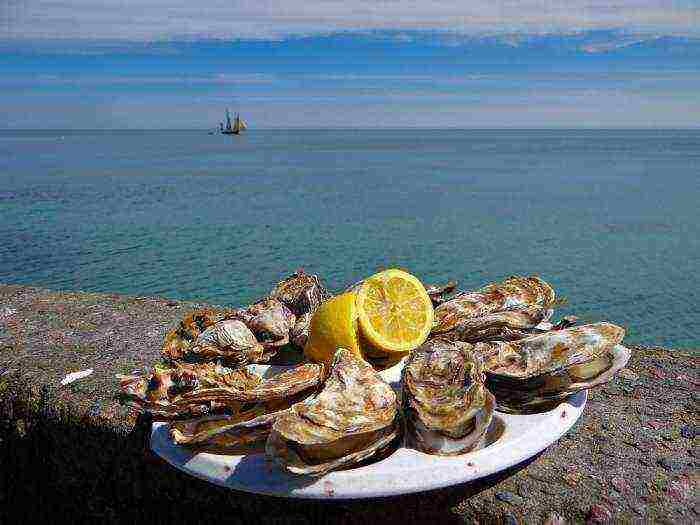
As for the offspring, the oysters spawn, and they begin to do it in the spring. The spawning period can last up to six months, ending by the end of the summer period. For a favorable roe throwing, oysters need rather warm water. The most interesting thing is that the eggs remain in the oyster until they are fertilized and hatch. Thus, already born mollusks emerge from the shell, which move through the reservoir until they find a suitable place to attach to it and begin their life.
The most valuable and high-quality at the moment are Norwegian oysters, which are collected in natural Norwegian waters. Also on the market you can find oysters from other countries: Japan, USA, South Korea and others.
When choosing oysters, you should pay attention to their freshness. Fresh oysters should have a solid color. Their sash must necessarily fit snugly to each other, without even having the smallest crack (see photo). If you notice a small slot between the shutters, this means that the oyster is stale, and it is better not to use such shellfish as food, otherwise, you can get serious poisoning.
Types of oysters
Today, about fifty different types of oysters are known, most of which are edible. Formally, all types of oysters are divided into two types: flat and deep.
The flat-faced oyster includes four distinct varieties of shellfish that differ in taste, appearance and market value. The flat type of oysters includes the following varieties:
- The most sought-after flat oysters by gourmets are Maren Oleron... They have a very delicate structure, rich taste and delicious aftertaste. They are the most popular representatives of this type of oyster.
- Belon Is another type of flat oyster that is harvested in the French province. It differs from its relatives in appearance, color in light gray tones, and also has a rather pungent odor.
- Bouzigues Is a type of flat oyster found only in the Mediterranean. They differ from other types of oysters in that, when eaten, they emit a spicy aroma, and they also have a pronounced salty taste.
- The yellow-green shell and small size characterize the type of oyster called Gravette... Unlike its relatives, this type of mollusks, although not large in size, has a very fleshy body.
Deep oysters are mainly collected only within the Pacific Ocean. This type of oyster is usually divided into two categories: gourmet and special. Gourmet ones have a slightly smaller amount of juice and meat than special ones, which differ significantly in price.
It is customary to grow this type of oyster in special tanks, which are filled with special algae. Keeping oysters in such tanks improves the quality of the oyster. The deep look of oysters comes in five varieties:
- The highest fat content and light salty flavor characterizes oysters. Fin de Claire... They are contained in tanks and supplied with algae as an additional source of nutrition.
- Oysters that are larger and also contain more meat are called Specialist... This type of oyster is kept in tanks for up to two months in order to saturate the oyster with the necessary elements.
- Blue Oyster differs in a specific color, which is achieved by keeping mollusks in a special aquarium, which includes blue clay. Thanks to her, this type of oyster contains a huge amount of useful trace elements.
- Croesus Is an Irish type of oyster that is characterized by high fat content and high meat content.
- Oysters, which differ from their counterparts in a rather graceful shell shape, as well as a sweetish pleasant aftertaste, and the smell of iodine, are called White pearls.
The maximum known size of this type of oyster is 50 centimeters. But such individuals are very rare. On average, the size of deep oysters varies between 5-20 centimeters.
How to open?
Those who have come across oysters know that opening them is not as easy as it might seem at first glance. First of all, it is necessary to clarify that in no case should you open oysters with hammers or any other objects that can injure the shell, otherwise you can spoil the taste of the oyster.
To open the oyster correctly, you need to arm yourself with a small sharp knife, or even better with a scalpel, and carefully draw along the line of connection of the shell valves. This will cut the muscles of the clam that hold the shell back, allowing you to open it up.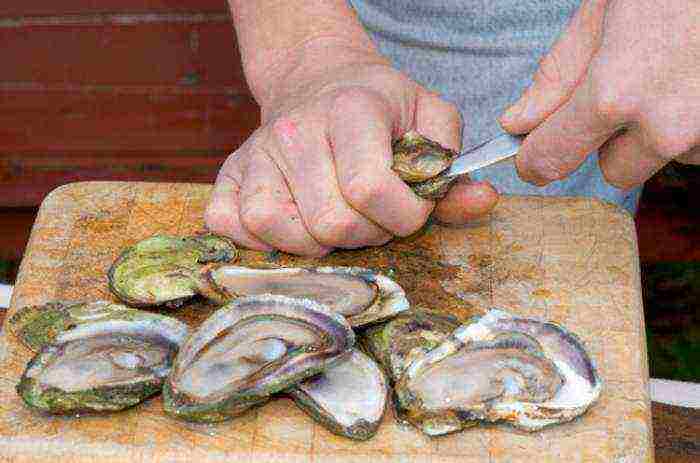
How to eat correctly?
If you decide to visit a French restaurant, then you should definitely try the oysters! If you don't know how to eat them correctly, it doesn't matter! We will enlighten you in this matter.
To begin with, I would like to note that if you decide to cook and taste oysters at home, then they are served on a tray in a multiple of six. There should also be fresh lemon wedges on the tray to add sophistication to the dish. You should definitely serve white wine with oysters, since only in combination with this drink can oysters reveal their full taste.
If you are going to eat oysters in a restaurant, then first you need to make sure that the oyster is fresh. It is very simple to determine this: the flaps of the sink must be closed. As a last resort, they open right in front of visitors to showcase the freshness of the oyster. Do not order or consume oysters that have already been opened, as they may be spoiled.
And eating oysters correctly is very simple: take an open oyster shell in your left hand, and a two-pronged fork in your right hand, which is designed for this purpose. The teeth of the fork should be brought under the body of the mollusk, and then, with gentle movements, remove it from the shell. The oyster can be dipped in the served oyster sauce, or you can apply it directly to the clam while it is still in the sink. It is also customary to sprinkle oyster meat with lemon juice before eating.
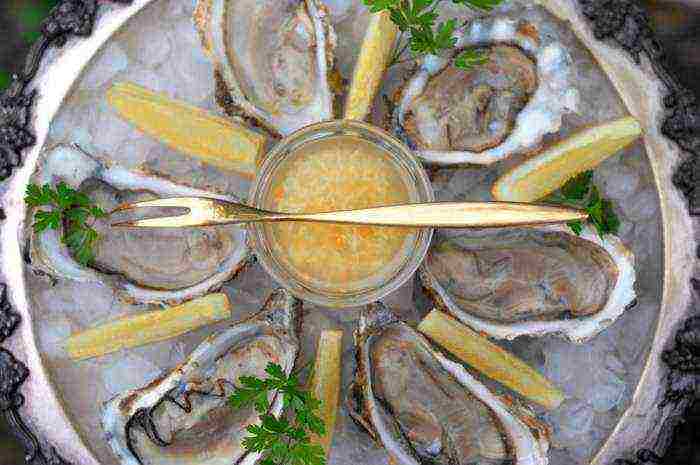
You can't chew an oyster. It is swallowed in one stroke and then washed down with white wine. It is also not customary to drink the liquid from the oyster shell. There may be sand if the oyster was caught during a storm.
Cooking secrets
To learn how to properly cook oysters, you should clarify that you only need to buy fresh oysters with tightly sealed shells.
If you already have fresh raw oysters on hand, then you can start cooking. There are a lot of recipes for cooking oysters. They can be added to salads, served as a separate appetizer, or complemented with other dishes.
Most often, oysters are cooked using the baking method: due to the content of juice in the shell, the oyster is baked in it, and then served. Before baking, the sink must be free of dirt and algae! Also, for cooking oysters, the method of stewing in the shell and without it is used.
Oyster meat can be cooked and fried by especially enterprising people, but this is not entirely correct. The best way to cook oysters is the baking method, adding aromatic spices to taste.
Beneficial features
There is no doubt about the beneficial properties of oysters. Like most of all seafood, oysters have a beneficial effect on the human body, helping it to strengthen the immune system and even get rid of some diseases. So, oyster meat has a good tonic effect, and also, due to the content of various amino acids in it, it can neutralize the development of cancerous tumors.Also oysters able to enhance sexual desire, being one of the best aphrodisiacs.
Thanks to the zinc contained in oysters, this product is able to normalize testosterone production and put hormones in order.
The harm of oysters and contraindications
The harm of oysters is rather doubtful. Oysters can only harm people who are allergic to them and seafood in general. There are very few contraindications for oysters: it is not recommended to use them only for people with allergies, as well as for pregnant women in the last stages of pregnancy. Also, oysters can be harmful if they are stale.
Compound
The composition of oysters can be envied by most of the seafood. Oyster meat contains elements such as proteins, fats, glycogenic carbohydrates, as well as a large amount of vitamins, in particular, there are a lot of B vitamins in them.
As for minerals, oysters contain iodine, potassium, calcium, zinc, phosphorus, iron and copper. With all this, the amount of mineral content in oysters is so high that six oysters will be enough to replenish the daily supply of minerals for the body.
Among other things, oysters contain amino acids and saturated fatty acids, such as omega-3, which, when consumed regularly, can have a positive effect on the immune system, as well as fight the growth and spread of cancer cells.
Oysters and mussels: differences
Most molluscs with shells are very similar to each other, and oysters with mussels are no exception. Many people ask the question: "What is the difference between oysters and mussels?" In fact, everything is very simple:
- Unlike oysters, mussels do not have a muscle layer that holds the shell valves. Because of this, it is easier to open it.
- The shell of the oyster is rough, while the shell of the mussel is flat and smooth.
- Due to the absence of a muscle layer between the valves, there is often a lot of sand and dirt in the mussel shell. This makes them significantly different from oysters.
- The fresh storage time for mussels and oysters varies. If the oysters can be stored for up to a week, then the mussels stay fresh for no more than 12 hours.
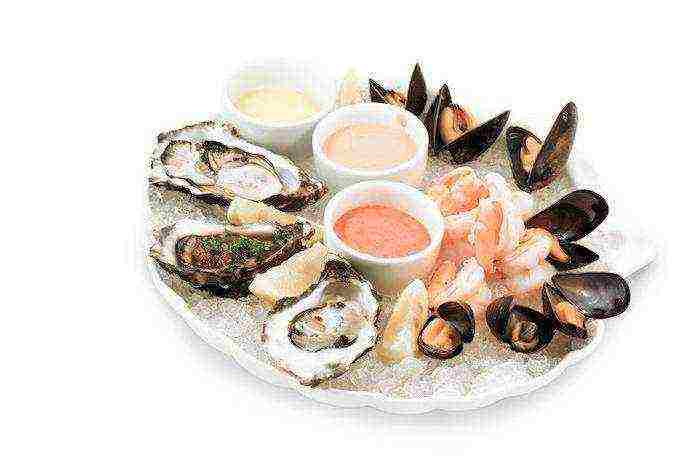
Among other things, oysters and mussels vary greatly in price. Mussels are rightly called oysters for the poor. But if we discard all the shortcomings, then the composition of mussels is practically no different from the composition of oysters.
Tips
Despite the fact that finding oysters in Russia today is problematic, we all travel and often buy them in markets or in stores. We share the rules on how not to make a mistake in choosing.

Oysters are one of the most beloved French delicacies. Today they are bred in the USA, Japan, Portugal, Ireland, Canada, Australia, Norway, Spain and France itself.
Before the imposition of sanctions, oysters were supplied to Russia from France. However, in our country, the culture of their use has not taken root. This was partly due to the rather high price.
Despite the fact that finding oysters in Russia today is quite problematic, we all travel, visit Europe and either buy oysters in markets or in stores, or order them in restaurants. At the same time, it is important to know how to choose them correctly, because poisoning with this delicacy is easier than ever.
Rule # 1: when to buy
In May and August, oysters multiply, and it is during this period that it is not recommended to eat them, since at this time they have a very specific taste. During this period, their body, instead of transparent, acquires a dull white hue, becomes more greasy and changes taste. There is one golden rule among the French - oysters can only be eaten in the months with the letter "r" in the name.
Rule # 2: which ones to choose
Make sure your oysters are covered and slightly damp. Check if they are alive. To do this, just open one of the oysters, drop a drop of lemon juice and press on it with a knife. If the oyster moves, then it is alive.
You should also pay attention to the weight of the oyster by placing the shell on your palm. If you feel heavy, it means that water has accumulated inside the shell, which is a sign of the quality of the oyster.
To understand how high-quality the product you are buying, take two shells in your hands and hit one against the other. If the sound produced is dull and solid, then you made the right choice.
When shopping for packaged oysters in supermarkets, look for an identification mark with information about the type, origin and date of packaging.
Rule # 3: Oyster Size
Oyster size numbering system is directly proportional to its taste. The grading system starts at number 5 (smallest and youngest oysters) and goes up to number 1 (or 0). Oysters number 2 or 1 are considered the greatest delicacy in European restaurants.
Rule # 4: where to buy
If you suddenly find yourself, for example, in France or Australia, then without hesitation, buy oysters at the fishermen's markets. In addition to assuring the quality of the product, there are tons of free tips on how to open and eat oysters.
Buy oysters carefully in supermarkets. Especially if these are shops with low traffic. Choose places where oysters simply cannot be stale, as they are quickly taken apart.
Rule # 5: where to store
If you bought oysters earlier than a day before serving, put them in the refrigerator and cover with a damp towel. In this way, you can store them for a week, but not more. If you notice that the oyster has opened its doors and does not respond to the touch of a knife, then you can safely throw it away.
Rule # 6: As Is
Serve the oysters raw, live, uncovered on finely chopped ice, with lemon, vinegar sauce and butter canapes. As a drink, it is best to serve semi-dry champagne, nutmeg or red wine.

